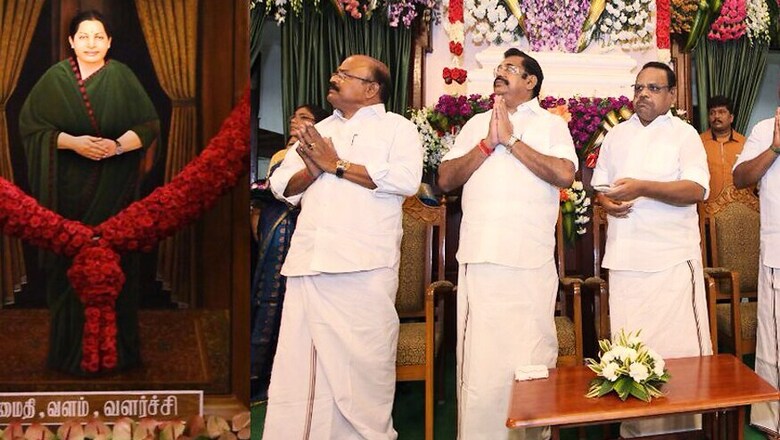
views
The symbolism of putting up Jayalalithaa's portrait at the Tamil Nadu Assembly is not lost on anyone. After all, the decision to do so perhaps is the only one that the warring factions of AIADMK agree upon.
But then, given the 2017 Supreme Court judgment in the disproportionate assets case, the Assembly is not the place for Jayalalithaa's portrait to be put up and that is what the political class and civil society are concerned about. Ethically and morally, to put up the portrait of a person, who would have most likely gone to jail in the case but for her demise, is wrong.
The Supreme Court, in its order on February 14, 2017, said that the appeals against Jayalalithaa stood abated with her death in December 2016. But the three other accused, including Jayalalithaa's close aide Sasikala, were convicted and are now lodged at the Bengaluru Central Prison.
It is important to note that the apex court did not mince words in damning Jayalalithaa's role in the entire conspiracy. It noted that the case was “startling” in the way corruption was carried out by the accused persons with sheer impunity. The two judge Supreme Court bench said Jayalalithaa did not accommodate Sasikala at Poes Garden not out of some “philanthropic urge” but because of a cold-blooded calculation to keep herself secure from any legal complications which may arise of their criminal activities.
“We have analysed the evidence adduced by the parties and we come to the conclusion that A1 to A4 (Jayalalithaa, Sasikala, Ilavarasi and Sudhakaran) entered into a conspiracy and in furtherance of the same, A1 (Jayalalithaa), who was a public servant at the relevant time, had come into possession of assets disproportionate to her known sources of income during the check period (1991-96) and had got the same disbursed in the name of A2 to A4 and the firms and the companies involved to hold this on her behalf with a masked front,'' said the judgment.
It is pretty obvious that the abatement of charges was only a technicality under law. In the eyes of the Supreme Court, Jayalalithaa was guilty and the tone and tenor of the order established what they thought of her criminality.
The court accused Jayalalithaa of misusing her public office, who “masked banking exchanges”, acquired “vast tracts of land” for pittances and conspired with her co-accused at Poes Garden only to later “feign ignorance”. The court, in fact, said that Jayalalithaa “knew fully well that Sasikala would be dealing with her funds credited to her account in Jaya Publications”.
But with a worldview that Jayalalithaa was all white; the impropriety of unveiling her portrait at the House of people's representatives clearly does not dawn on the AIADMK because politically, it was important for the Edappadi Palaniswami government to unveil the portrait. It was their way of showing that they are the inheritors of Amma's legacy.
At a time when the ruling faction is making serious attempts to win over the rebel MLAs from the TTV Dhinakaran faction, the Amma factor could serve as the ideal glue. Also, serious doubts over how long the EPS government will last, explains the hurry in getting over with the ceremony.
The original plan was to have Prime Minister Narendra Modi unveil the portrait. Though he did not grace the occasion, the Bharatiya Janata Party was the only other party that supported the move to have Jayalalithaa's portrait in the Assembly. What it exposes is the BJP's hypocritical stand on corruption. While the party goes hammer and tongs against Lalu Yadav's corrupt dealings because he is a political opponent, it remains soft on the AIADMK supremo, who too, had been similarly indicted by the court.
On the other hand, an alternate argument that comes forth is that the DA case should not take away from Jayalalithaa's work as the chief minister of Tamil Nadu. That with her welfare schemes she proved to be a good administrator. This is part of an AIADMK-sponsored attempt to pin all blame on Sasikala, while trying to establish in the public eye that Jayalalithaa was kept in the dark about the misdeeds committed by the Mannargudi gang.
This is an explanation that only the gullible would fall for because it does not explain why Jayalalithaa would stick with Sasikala and her relatives at Poes Garden for over 20 years after the case broke if she was so upset about them carrying out illegal activities behind her back.
The opposition parties in Tamil Nadu — the DMK, PMK and Congress — boycotted the event on Monday. They have also approached the Madras High court, opposing a “convict's portrait” inside the Assembly.
Unveiling Jayalalithaa's portrait reveals the AIADMK government's “don't care” attitude to political corruption. India then might as well do away with courts and not file cases of disproportionate assets against anyone in public office. The question lies on the precedent this sets in Tamil Nadu and elsewhere in the country.
— Author is a senior journalist. Views are personal.















Comments
0 comment